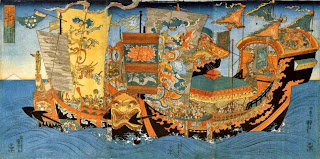大阪好玩處 彌生人

徐福渡海圖 朋友們你們到大阪除了買東西,去電影城,有沒有想到你祖先,特別是江浙或者從膠東半島來到日本以後的生活嗎。 圖是徐福帶三千男女來日本圖,當然這只是一個神話。但是,至少有三千個男女來到日本,而是在3000年前,比徐福來日本早800年,那些人叫做彌生人 ,安倍總理也是他們的後代。 從關西機場到大阪,如果你乘坐JR到天王寺,中間有個車站叫信太山 (Shinodayama),你的快車可能一瞬間而過,但是如果你膩了買東西,你可試一試用半天時間去訪問你的3000年前的老鄉,生活的怎麼樣,住的怎麼樣,並且欣賞一下大阪的鄉間風景。 從JR天王寺車站到信太山 (Shinodayama)只需要20分鐘左右的時間,但是小心,在鳳(O-TORI)車站要轉乘慢車。大阪彌生博物館和池上曾根遺跡就在信太山車站走路700米的地點。 你一下信太山,就要穿過鐵路交叉口,馬上就發現馬路上鋪著黃沙石,這是為引導參觀客人到遺跡和博物館。 通道兩邊是一個獨特的日本房屋,牆壁的木材都是燒焦的,這並不是火災燒過的,而這是傳統燒杉板壁,把杉板事先燒焦以防木牆腐蝕是老傳統的日本板料。 正在你觀賞這些老房子和門前的花兒,就到了池上曾根遺跡了。 池上曾根遺跡是回复當時村子原狀的一個露天展覽,離開遺跡不遠處就有博物館,只要你稍微事先了解了彌生人,我想這個地方可以給你提供和一般日本遊完全不同的經驗。 我是送人到關西機場後回路去的,從關西機場就要40分鐘,在和泉府中(Izumifuchu)站轉慢車。一站就到。
